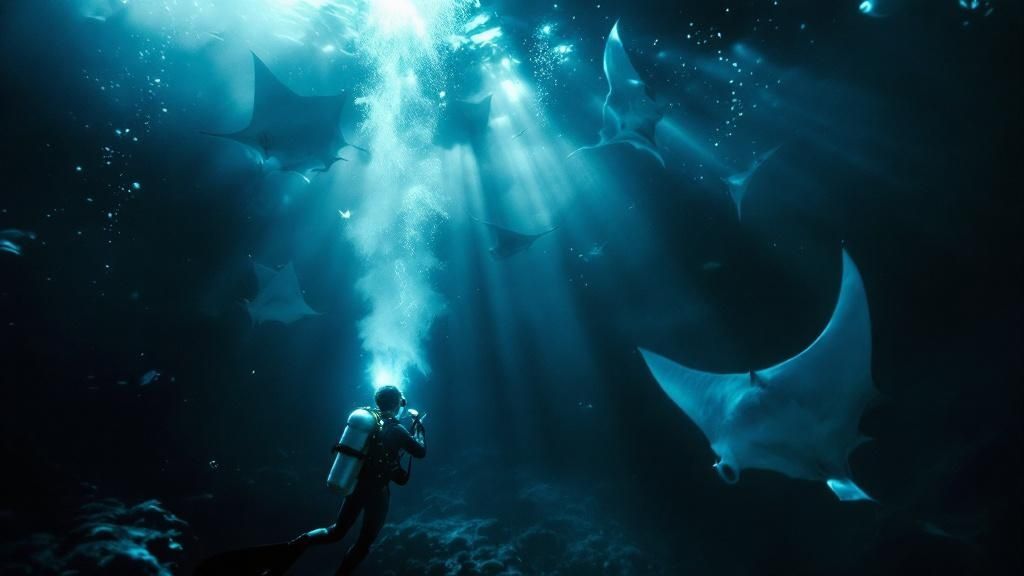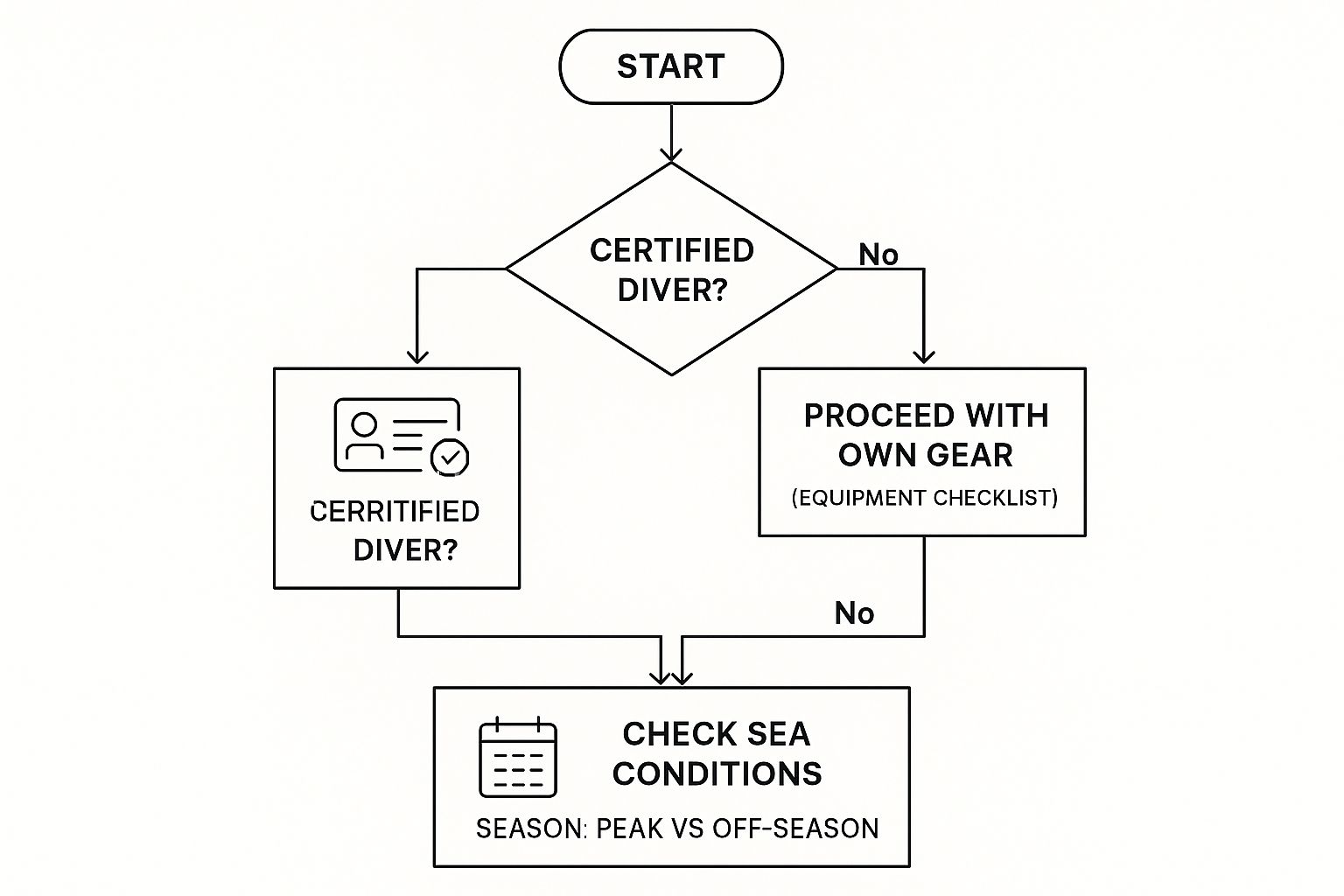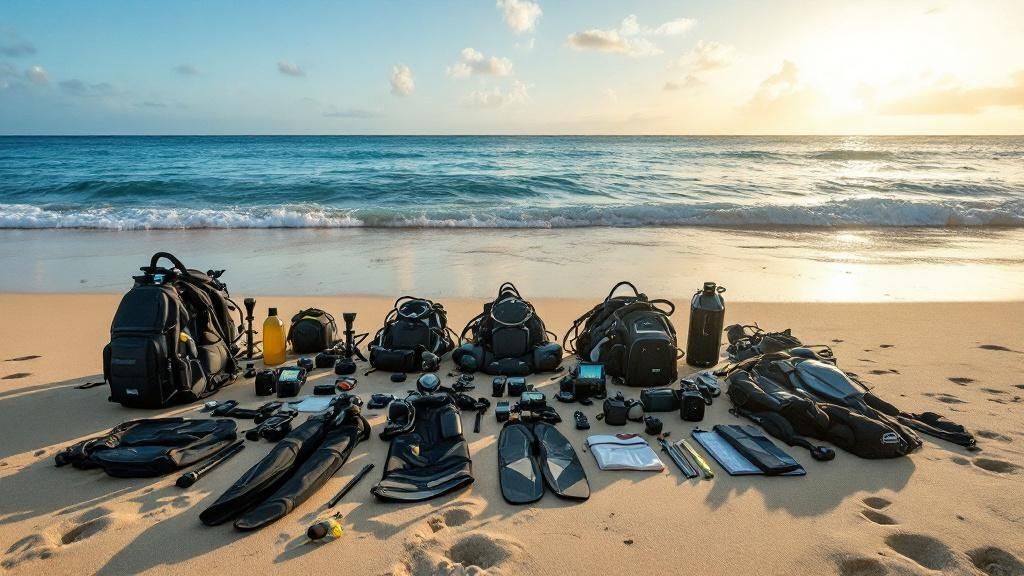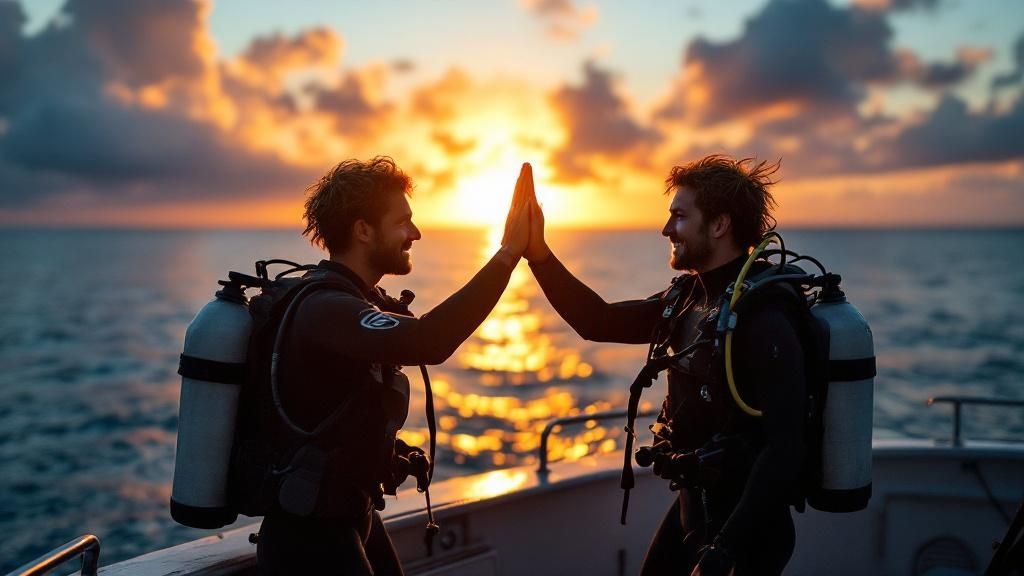Why Kona Creates The World's Most Magical Manta Encounters
Picture this: you're floating in the dark, warm Pacific Ocean, and a creature with a thirteen-foot wingspan gracefully glides inches away from you. This isn't a rare, once-in-a-lifetime stroke of luck. It's the predictable and awe-inspiring reality of the manta ray dive Kona is renowned for. While spotting mantas in other parts of the world can be a hit-or-miss adventure, Kona offers something truly special: consistent, year-round encounters with these gentle giants. This reliability isn't magic; it's the result of a perfect blend of geology and biology.
The secret lies in Kona's unique underwater terrain. The steep volcanic slopes of the Big Island plunge directly into deep water, creating a phenomenon called upwelling. Think of it as an ocean elevator that brings cold, nutrient-rich water from the depths up to the sunny surface. This process acts like a powerful fertilizer for microscopic life, creating huge blooms of plankton—the manta rays' favorite meal. Kona's geography has essentially created a permanent, all-you-can-eat buffet that has drawn mantas to these shores for generations.
The Science Behind the Spectacle
This natural buffet is the foundation of one of the world's premier wildlife experiences. Years ago, dive operators learned that shining powerful lights into the water at night attracted even more plankton, supercharging the feeding frenzy. Today, divers and snorkelers become quiet spectators at this underwater feast. You simply hold your spot in the water, and the mantas perform a mesmerizing ballet, swooping and looping through the beams of light to filter-feed. It's a prime example of how humans can interact with nature, enhancing a natural behavior without disturbing the animals.
The result is an encounter that feels both untamed and incredibly personal. This unique setup has made the manta ray dive Kona experience a global benchmark. The numbers are impressive: the Kona coast attracts about 80,000 visitors annually for manta tours, with a remarkable 80-90% success rate for sightings year-round. The consistency is so high because the manta population is residential; these are local mantas, not just visitors passing through. This high probability of success lets you plan your trip with confidence, knowing a magical experience is almost guaranteed.
A Predictable Paradise for Marine Life
It's not just the deep water and plankton that make Kona the perfect spot. The coastline is also dotted with calm, protected bays that shield the area from strong ocean currents and big waves, especially on the leeward (sheltered) side of the island. These tranquil conditions are perfect for both the mantas and the dive boats, ensuring a safe and comfortable environment for everyone on these nighttime adventures.
This combination of factors—a reliable food source, established feeding sites, calm waters, and a resident manta population—is the recipe for the most dependable and enchanting manta encounters on Earth.
Decoding Manta Ray Behavior: What Makes These Giants So Special
To get the most out of your manta ray dive in Kona, it helps to know a little about the incredible creatures you're about to meet. Think of them less as giant fish and more as intelligent, underwater ballet dancers. Every graceful swoop and turn is a deliberate movement, a way they communicate. Learning to "read" their body language can turn your dive from a simple sightseeing trip into a meaningful interaction with one of nature’s most majestic animals. These aren't just big, passive creatures; they have complex social lives and even unique personalities that scientists are still learning about.

Reading the Underwater Body Language
Understanding a manta's behavior is the key to a respectful and unforgettable interaction. If a manta ray glides toward you slowly and deliberately, it's often a sign of curiosity and shows it's comfortable with your group. On the other hand, sharp, sudden turns or fast swimming are clear signals that the animal feels crowded and needs more room.
By staying calm and still, you become a predictable, non-threatening part of their world. This encourages the mantas to approach on their own terms. This kind of passive observation is the foundation of an ethical manta encounter, making sure the animals are not disturbed.
Their huge size can be a bit startling at first, but it just adds to the magic. Manta rays in Kona can have wingspans up to 4 meters (about 13 feet), making them some of the largest in any tropical waters. Despite their size, their movements are smooth and gentle, a beautiful sight that makes seeing them up close even more awesome. You can learn more about the fascinating facts of Kona's mantas on seaquesthawaii.com.
Filter Feeders and Unique Individuals
These gentle giants are filter feeders. They use their special cephalic lobes—the horn-like fins on their head—to guide huge amounts of plankton-rich water into their mouths. Picture these lobes as a built-in conveyor belt, efficiently directing their food source. When a manta is feeding, its lobes are unfurled to catch as much plankton as possible. When it's just cruising around, the lobes are often rolled up tightly, giving it a more streamlined look.
One of the most amazing things about Kona's manta population is that each one is an individual. Just like a human fingerprint, every manta ray has a unique pattern of black spots on its belly. Researchers use these patterns to identify and track them, giving them names and following their life stories. This means the manta you see on your dive could be a famous local like "Big Bertha" or "Lefty." For more on when you can see them, check out our guide on the best time of year to see manta rays in Kona. Knowing this adds a personal touch to your dive, turning it from just watching wildlife into a possible meeting with a known underwater celebrity.
Planning Your Perfect Manta Encounter: Timing And Preparation
A successful manta ray dive in Kona isn't just about showing up; it’s about smart planning that aligns with the natural world. While Kona is a year-round destination for manta sightings, certain factors can elevate your experience from great to unforgettable. Think of it like booking front-row seats to a spectacular show—a little preparation ensures you get the best possible view.
Getting ready for your underwater adventure is straightforward. This visual guide breaks down the simple steps to consider before you even book your tour.

This flowchart simplifies your planning process, highlighting key decisions like renting gear and considering the time of year for your trip.
Choosing The Best Time To Go
Surprisingly, one of the biggest factors influencing your manta encounter is the phase of the moon. While tours run nightly, the darkness of the sky plays a crucial role. New moon periods, when the sky is darkest, often lead to the most intense feeding activity. The stark contrast between the black water and the bright lights used by tour boats makes the plankton cluster more densely, creating a buffet that mantas can't resist.
Weather also plays a major part. The best season for a manta ray dive in Kona is generally from late spring to early fall (April to October). During these months, the ocean is typically calmer, and the winds are milder. This means you can expect:
- More comfortable and stable boat rides.
- Improved water clarity for amazing views.
- A lower likelihood of tours being canceled due to rough seas.
Winter trips are still incredible, but be aware that the ocean can be choppier from November to March. If you’re visiting during this time, it’s a good idea to book your manta tour for the beginning of your vacation. This provides a safety net, giving you time to reschedule if bad weather forces a cancellation.
Deciding Between A Dive And A Snorkel
When it comes to seeing the mantas, you have two amazing options: scuba diving or snorkeling. The right choice depends entirely on your comfort level in the water and whether you have a scuba certification. Neither is "better"—they just offer different perspectives of the same incredible underwater ballet.
To help you decide, here’s a breakdown of what each experience involves.
Diving vs Snorkeling: Choosing Your Manta Experience
Comparison of diving and snorkeling options for manta ray encounters, including requirements, experience levels, and what to expect
| Experience Type | Requirements | Best For | Advantages | Considerations |
|---|---|---|---|---|
| Snorkeling | Basic swimming ability | Families, non-certified individuals, and anyone new to being in the ocean at night. | Fantastic top-down views, less equipment to manage, and typically a lower cost. | You'll be viewing the mantas from the surface, looking down as they glide beneath you. |
| Diving | Open Water Scuba Certification | Certified divers who want to be fully immersed in the experience. | A 360-degree view from the seafloor, making you feel like you are part of their world. | Requires a scuba certification and involves managing more gear. |
Snorkeling is an accessible and thrilling option. You'll float at the surface, holding onto a specially designed light board that attracts plankton, and watch as mantas soar just inches below you. For divers, the experience is more immersive. You’ll settle on the sandy ocean floor and watch the gentle giants dance and feed in the water column above and around you.
Ultimately, both options provide a front-row seat to one of nature's most magnificent displays, guaranteeing a truly memorable encounter with Kona's beloved manta rays.
Night Diving Essentials: Gear And Safety For Magical Encounters
Diving into the ocean after the sun goes down adds a unique layer of excitement, making the manta ray dive Kona offers even more special. Being properly prepared is the secret to a great dive, as it lets you focus on the graceful giants gliding before you instead of struggling with your gear. While most tour operators supply the necessary equipment, knowing what each piece does helps build confidence for a smooth experience from the boat to the seabed.

The image above from PADI shows how specialized training can prepare divers for low-light conditions. Getting a certification for night diving gives you the skills to confidently handle tasks in the dark, from checking your gauges to communicating with your buddy.
Gearing Up For The Night
Choosing the right equipment for Hawaii’s warm waters is less about staying warm and more about comfort and protection. Here’s what you should know:
- Wetsuit: A thin 3mm wetsuit is typically all you need. Think of it not as winter insulation but as a protective second skin. It guards against accidental scrapes and, crucially, keeps you from getting chilled during the 45-60 minutes you’ll be mostly still on the ocean floor, helping you remain calm.
- Mask and Fins: A leaky mask or fins that give you cramps are major distractions. A well-fitting mask ensures your view is unobstructed and crystal-clear, while comfortable fins let you move with minimal effort when necessary.
- Lights: The specialized dive lights are the true stars of the equipment list. They have a dual purpose: attracting the microscopic plankton that manta rays feed on and giving you the visibility needed to move around safely in the dark.
Safety In The Dark: Your Top Priority
Safety rules for a night dive are stricter than for a daytime one. Your pre-dive briefing will walk you through important procedures designed for low-light environments. A critical part of this is mastering the buddy system in the dark, which depends on light signals and staying close to your partner. You’ll also learn emergency procedures specific to the unique setting of a manta ray dive in Kona.
It's completely normal to feel a bit nervous before your first night dive. The best way to handle this is through solid preparation and by trusting your divemaster, who is an expert in these conditions. Mental techniques like controlled breathing and visualizing the dive can help you stay calm and fully in the moment. Staying relaxed creates a non-threatening atmosphere, which leads to the best manta interactions. To learn more about what makes this experience so incredible, you can read about the Kona Honu Divers manta ray night dive.
Ultimately, being well-prepared with the right gear and a safety-first mindset is the final step before you slip into the water for a truly unforgettable encounter.
Your Underwater Encounter: What To Expect In The Water
This is the moment you've been waiting for. As you roll back into the dark Pacific, the world above disappears, replaced by a quiet, deep blue. The only light cuts through the darkness from powerful beams on the boat and a central "campfire" of lights on the ocean floor, creating a brilliant stage in the black water. This initial descent on your manta ray dive in Kona is a mix of thrill and calm as you get used to being underwater at night. Your guide will lead you to your spot on the sandy bottom, where you'll get settled and wait for the show to begin.
The Arrival of the Mantas
Suddenly, a shadow moving in the distance takes shape, gliding out of the darkness like a silent, graceful giant. The first manta ray arrives, its huge wings propelling it in a weightless underwater dance. Before you know it, another appears, and then another. They perform amazing barrel rolls and swooping loops, coming within inches of your head as they feed on the plankton drawn to the light. You can hear the soft whoosh of water as a manta with a 12-foot wingspan passes by and feel the slight shift in pressure. It's a mesmerizing ballet happening right in front of you.
Your dive will last about 45 minutes, and your main role is simple: be a calm and respectful guest. Following your guide's instructions is vital for a great view and for the safety of both you and the mantas.
- Stay Low: Find your spot on the sandy seafloor and stay there. This gives the mantas a clear, open space to swim and feed above you.
- Lights Pointing Up: Aim your dive light straight up into the water column. Don't shine it at other divers or directly into the mantas' eyes. This concentrates the plankton in one area, creating a reliable food source for the rays.
- Look, Don't Touch: This is the most important rule. Never touch, chase, or try to ride a manta ray. Their skin is covered in a protective slime coat, and human touch can damage it, making them susceptible to infections. Let them approach you.
The Emotional Connection
More than just a visual spectacle, many divers talk about a deep, emotional feeling. When a manta ray glides just above you and seems to make eye contact, you feel a real sense of intelligence and curiosity. It's a powerful connection that’s hard to describe—a moment that can change how you see the ocean and its inhabitants. This feeling of awe is a key reason why the manta ray dive in Kona is considered one of the world's top wildlife experiences. To learn more about how this incredible adventure is organized, check out our guide on the manta ray night dive in Kailua-Kona. You're not just observing animals; you're sharing a moment with individual creatures, and it’s a privilege you won't soon forget.
Capturing The Magic: 7 Tips For Photography And Making Memories Underwater
Wanting to document your manta ray dive in Kona is a natural instinct, but it presents a unique set of challenges. Taking pictures means you have to balance getting incredible photos with the need to stay present for this once-in-a-lifetime experience. The low light, fast-moving mantas, and the priority of keeping the animals safe create a tricky environment, even for experienced photographers. However, with the right approach and a few key techniques, you can capture memories that truly reflect the magic without spoiling the moment or disturbing the mantas.

Flash Photography and Manta Safety
The question of whether to use flashes or strobes around manta rays is a serious one. Both extensive research and expert observations have confirmed that powerful, repeated flashes can disrupt a manta's natural feeding behavior. The sudden bursts of light can disorient them, cause them to shy away from the light, or even drive them away from the feeding area entirely. Because their feeding is so essential, reputable tour operators strictly enforce a "no flash" policy. This isn't about ruining your shot; it's about being a respectful visitor in their underwater home.
Your best strategy is to work with the ambient light. The powerful lights from the tour boat and the underwater "campfire" of dive lights create a beautifully illuminated stage. Learning to use this existing light will result in more authentic, atmospheric images that capture the genuine feeling of the dive. Many top underwater photographers who specialize in manta imagery agree: the best shots come from patience and smart positioning, not from powerful strobes.
Practical Photography and Memory-Making Tips
You don’t need a high-end professional camera to bring home amazing memories. Sometimes, getting caught up in complex camera settings can make you miss the most incredible moments. Instead of spending the whole dive looking through a viewfinder, think about a more balanced way to document your experience.
Here are a few practical strategies for capturing the magic responsibly:
- Set and Forget Your GoPro: Small action cameras like the GoPro are ideal for this kind of dive. Set it to record video with a wide field of view, then either mount it to your gear or just hold it steady. This allows you to capture the whole scene while you soak in the experience with your own eyes.
- Use the Buddy System: Coordinate with your dive buddy and take turns being the designated photographer. One person can focus on shooting for ten minutes while the other fully immerses themselves in the moment, and then you switch. This guarantees that you both get great photos and an uninterrupted experience.
- Practice 'Mental Photography': This might be the most valuable technique of all. For part of the dive, just put the camera down. Focus on the details—the unique spot patterns on a manta’s belly, the quiet rush of water as one glides just inches above you, the intelligent look in its eyes. These sensory details create memories far more vivid than any camera can capture.
- Keep a Post-Dive Journal: Soon after the dive, take a few minutes to write down or sketch what you saw and how it made you feel. This simple practice helps solidify the memories and often captures the emotional nuances that a photograph can't express.
To help you prepare, here is a guide to camera equipment and settings that work well for the unique conditions of a manta ray night dive.
| Equipment Type | Recommended Settings | Pros | Cons | Price Range |
|---|---|---|---|---|
| Action Camera (e.g., GoPro) | Video: 4K at 30fps, Wide or SuperView lens, Image Stabilization ON. Photo: Night Photo mode, RAW format. | Small, easy to use, wide field of view captures the whole scene. Great for video. | Lower image quality in dark conditions, limited manual control. | $250 – $450 |
| Compact Underwater Camera | Aperture: f/2.8 or lower. Shutter: 1/60s. ISO: 800-1600. Focus: Continuous AF. White Balance: Custom/Underwater. | Good balance of quality and portability. More manual control than an action cam. | Can struggle with autofocus in low light. Smaller sensor than DSLRs. | $400 – $900 |
| DSLR/Mirrorless with Housing | Lens: Wide-angle (16-35mm). Aperture: f/2.8-f/4. Shutter: 1/80s. ISO: 1600-3200+. Focus: Continuous AF. | Highest image quality, best low-light performance, fast autofocus. | Bulky, expensive, and complex to operate, especially for beginners. | $2,000 – $7,000+ |
| Video Lights (External) | Use two lights on arms to reduce backscatter. Set to medium-low power to avoid disturbing mantas. | Provides consistent, even lighting for video. Reveals true colors. | Adds bulk and cost to your setup. Requires careful positioning. | $300 – $1,500+ |
Ultimately, whether you use a high-end camera or just your own eyes, the goal is the same: to appreciate the incredible grace of these animals. Finding the right balance between capturing the moment and living in it will ensure your manta ray dive is an experience you’ll never forget.
Beyond The Dive: Making Your Manta Experience Count
Witnessing the underwater ballet of a manta ray dive in Kona often sparks a profound connection that stays with you long after you’ve toweled off. This powerful experience is more than an incredible vacation highlight; it’s an open door to understanding marine conservation and how you fit into the picture. The sense of awe you feel naturally leads to questions: What challenges do these gentle giants face? How is their plankton-rich ecosystem supported?
The answers reveal a delicate balance where microscopic life and global climate patterns are deeply intertwined with the survival of Kona’s mantas. This new awareness frequently inspires divers to take action. An up-close encounter with a manta ray can create a lasting change in perspective, turning you from a passive observer into an active ocean protector.
Becoming a Manta Ray Ambassador
It’s easier than you might think to carry the magic of your dive into your daily life. Your experience gives you a unique platform to be a voice for marine protection. Here are a few practical ways to make your encounter count:
- Support Local Research: Several organizations on the Big Island are dedicated to studying and protecting Kona's resident manta population. Contributing to these groups helps fund essential research into manta behavior, health, and habitat preservation.
- Share Responsibly: When you post your amazing photos and videos, add a message about conservation. Mention the "look, don't touch" rule and explain why it's so important for protecting the mantas' delicate skin. Your personal story can encourage others to be responsible eco-tourists.
- Embrace Citizen Science: Some research groups welcome divers to submit their photos of manta bellies. Because each manta has a unique spot pattern—like a fingerprint—your images can help researchers identify and track individual animals, adding valuable data to population studies.
Deepen Your Connection in Kona
While you're still on the Big Island, you can enrich your understanding of Hawaii’s amazing marine world. Complement your manta ray dive Kona experience with other activities that highlight the deep cultural and ecological importance of the ocean.
Visit local cultural sites to learn about the traditional Hawaiian relationship with the sea, or explore other unique marine ecosystems on guided snorkeling trips in different bays. These experiences add layers to your adventure, turning a single dive into a deeper appreciation for the entire marine environment. The wonder you felt watching the mantas can grow into a lifelong commitment to protecting our planet's oceans.
Ready to experience this life-changing underwater encounter for yourself? At Kona Honu Divers, we provide safe, respectful, and unforgettable manta ray tours led by our expert crew. Book your adventure with us today and become part of our ohana dedicated to ocean conservation.
